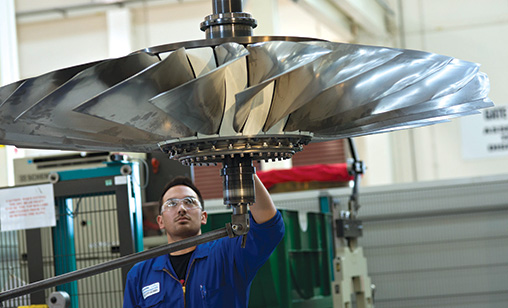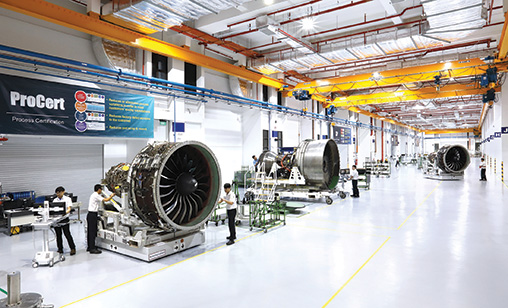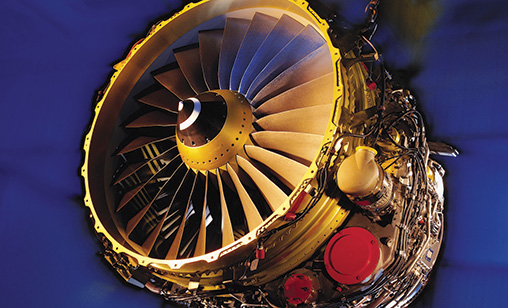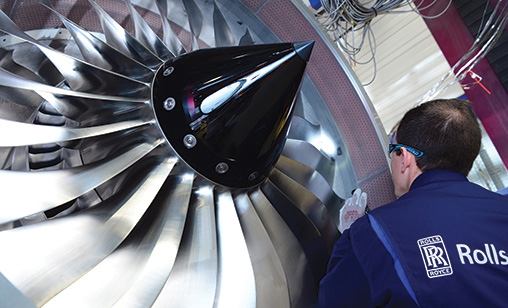Special Reports: MRO
Airline MRO revenue heads for 40% collapse
September 1st 2020
Hibernation of commercial aircraft across the globe from COVID-19 has changed the outlook for aviation’s MRO sector, Oliver Wyman’s latest Global Fleet and MRO Market Forecast reports. Read More »
A July forecast of the sector for the next two decades, updated from February, showed the number of aircraft in service in the Asia-Pacific had fallen by 61%, to 3,618 aircraft.
 |
Asia-Pacific airline fleets, which were operating 8,689 aircraft before the pandemic, now have approximately 5,334 of the region’s collective airline fleet in storage, Oliver Wyman said.
It said the “baseline scenario” for the global fleet was that it would remain below pre-COVID-19 levels until 2023, which would result in a significant reduction in MRO services.
“Given the current outlook and assuming our baseline scenario, global demand for maintenance, repair, and overhaul in 2020 would be about US$50.3 billion, 45% lower than our original pre-COVID forecast of $91.2 billion,” the consultancy said. “All regions in the world, aside from China, will experience declines in MRO spending of 40% or more,” it said.
DIFFICULT DECISIONS FOR MRO PROVIDERS
The impact of projected lower MRO spending was borne out in the latest quarterly results of Chicago-headquartered AAR Corp, one of the world’s largest aerospace and defence aftermarket services providers.
The company reported a net loss for the three months to June 30 of US$16.5 million, compared with a net profit of US$22.8 million in the same quarter last year, AAR Corp. reported in July. Revenue declined 26%, to US$416.5 million, AAR Corp said.
AAR Corp CEO, John Holmes, said difficult decisions to align costs with the lower demand environment included closing and consolidating some facilities, ending unprofitable product lines and exiting or restructuring underperforming commercial programs contracts.
The conglomerate has said its composites manufacturing operation was on the market, which Holmes said was not profitable in fiscal 2020 and “not core to our aviation services offering”.
“For MRO, we started the quarter with full hangers,” Holmes during AAR Corp’s results presentation. “Throughout the quarter we delivered aircraft. In many cases, those aircraft were not replaced by additional aircraft. So we did see a decline through the quarter. We are at a depressed level.”
 |
Holmes described dialogue with customers as “very dynamic”. While the maintenance schedule for the period ahead was still unclear, he thought there was a growing “backlog of maintenance requirements”.
“There is actually a very significant amount of deferred maintenance that’s building out there. So when we see a return to flying you might actually see a much quicker and more dramatic uptick in parts requirements and maintenance requirements,” he said.
“Nonetheless, MRO capacity has been reduced by about 20%.
“We have sized our MRO operation for a much smaller labour utilisation in this fiscal year than we would have last fiscal year,” Holmes said. “Against that smaller footprint as a percentage we are actually sold out approximately for the same percentage we would in a normal year. It’s just on a much lower base.”
Leading Asia-Pacific MRO, SIA Engineering Company (SIAEC) said the coronavirus pandemic had shredded revenue for the quarter to June 30 by 54.1%, to S$118.5 million (US$ 1.3 million), from S$258.1 million a year ago. Flight activity was picking up from June, but the MRO said the increase was “not material”. The reduced workload had shut down some of SIAEC’s engine and component joint ventures on specific days to reduce costs.
“At our Singapore base, the number of flights handled in the quarter was about 13% of what we handled pre-COVID-19,” SIAEC said in a business update in mid-July.
“Our base maintenance unit had fewer airframe overhaul checks and airline customers under our fleet management business saw a significant reduction in flying hours. Work volume at our engine and component joint venture companies also slowed as decreased flying hours resulted in extensions of maintenance intervals.”
SIAEC is redeploying staff to areas with work demand, including aircraft disinfection and preservation maintenance. Some airline customers also had brought forward maintenance checks.
PRATT & WHITNEY STAYS CLOSE TO CUSTOMERS
 |
Pratt & Whitney said it was expanding its MRO capability in the Asia-Pacific for its geared turbofan (GTF) engine, which features on the A220, the A320neo and the Embraer E2 aircraft family. It also powers the Irkut MC-21 and the Mitsubishi SpaceJet.
The business has included adding Air India Engineering Services Limited (AIESL) in March as an approved MRO for support of Pratt & Whitney GTF engines and customers in India. Its Singapore engine workshop, Eagle Services Asia, was upgraded in 2019.
“Across our network in the Asia-Pacific and globally, we are aggressively accelerating our MRO capability for the GTF family to incorporate available upgrades in anticipation of the recovery,” the aerospace conglomerate said.
In an emailed response to questions from Orient Aviation, Pratt & Whitney said “airlines need to maintain their fleets so when the market recovers they are ready to ramp up operations to meet market demand”.
Industry figures strongly indicate narrow-bodies have been the quickest to return to service. Pratt & Whitney said 75% of the global fleet of GTF-powered A220s were flying and 65% of A320neo family aircraft with the Pratt & Whitney GTF power plant were in service. [Our] Asia-Pacific airline fleet had a utilisation of around 50%, it said.
“From an MRO perspective, airlines operating on shorter routes means they are operating a higher number of cycles relative to flight hours,” Pratt & Whitney said.
“Engines fall due for maintenance based on number of cycles and the environment in which they are operating. The engines coming due for overhaul will predominantly be those on the smaller narrow-bodies.
“Pratt & Whitney is well positioned for the recovery in commercial aviation because our engines are predominately on the new narrow-bodies; the A220, A320neo family and the Embraer E2 as well as powering the A320ceo family.
“We are the clear market leader in turboprop engines. The PT6 and PW100 family of engines are ubiquitous thanks to being on a plethora of aircraft types.”
Pratt & Whitney said there had been a decline in engine overhauls required by airlines with many commercial engines on “power by the hour” programs.
The company was providing “comprehensive manuals, advice and support for preservation and storage of engines” from aircraft that have been parked.
Pratt & Whitney has field service representatives across the Asia-Pacific with some based on site and others using digital technologies, including engine data automatically transmitted to Pratt & Whitney’s analysis centre in Singapore as soon as an aircraft touched down to identify potential issues and conduct predictive maintenance.
A mobile application, Onsight by Librestream, features a two-way audio-visual link that connects Pratt & Whitney’s experts with the airline’s engineers on the ground.
The application conducts borescope inspections that remove the need and cost of the company having a staff member on site at the airline.
Subsidiary Pratt & Whitney Canada has developed a kit for airlines that extracts an oil sample from an engine and returns it by email in a pre-paid envelope within 48 hours.
“The restrictions on international air travel and lockdowns in some countries have meant the value of engine monitoring and diagnostics has come to the fore during the pandemic, because it can be done remotely,” Pratt & Whitney explained.
“COVID-19 has had a major impact on our commercial airline customers, which has affected us. It is vitally important we stay close to our customers and do what we can to help them during these difficult times, ” the company told Orient Aviation.
GE AVIATION ANTICIPATES STEEP MARKET DECLINE
 |
GE CEO, Lawrence Culp, said the company’s GE Aviation business had experienced a 50% drop in engine installations in July, compared with a year earlier, in line with fewer aircraft deliveries.
Commercial aftermarket services and shop visits were down 55% and billings from customised device agreements (CSA) had fallen 55%.
At July 31, about 31% of the GE/CFM fleet was parked, GE said in its quarterly results presentation. CFM International is a joint venture between GE and Safran Aircraft Engines. It makes engines for the A320 and 737 families among other programs.
“Services are critical to the recovery of GE Aviation as we generate a lot of cash here especially with narrow-bodies. They are more than 40% of our revenue,” Culp said during July’s GE’s quarterly results presentation.
“We are planning for a steep market decline this year and likely a slow multi-year recovery. Longer term, the aviation market has solid fundamentals and we’re committed to protecting the future of this business and our leadership position within the industry.”
ROLLS-ROYCE SAYS THERE ARE SIGNS OF RECOVERY
Already struggling, engine maker, Rolls-Royce, said at its calendar 2020 first half results presentation there had been about US$1.452 billion less cash inflow in the six months to June 30, due to lower receipts associated with wide-body engine flying hours and fewer engine deliveries.
“Wide-body engine flying hours fell by approximately 50% in the first half, compared with the same six months last year with an approximate 75% decline in the second quarter,” Rolls-Royce said.
 |
“Since the low point in April, when flying hours were down 80% compared to April 2019, we have seen early signs of recovery with a marginal improvement in May and June led by an increase in flights in China, the Asia-Pacific and the Middle East.”
COMPONENTS AND SPARE PARTS
The Oliver Wyman Global Fleet and MRO Market Forecast 2020-2030 report estimated spending on parts and materials, both used and new, would be US$26 billion in 2020, a 56% reduction from its forecast of US$60 billion pre-pandemic. The market was worth US$52 billion in 2019.
Spending on used serviceable materials (USM) in 2020 would be US$2.8 billion, representing about 11% of all spending on parts and materials. This represented a 40% fall, from US$4.7 billion, in 2019.
Oliver Wyman said MRO providers would face disruption in the USM market as inventory of sidelined and retired aircraft were stripped for parts.
“This cannibalisation will create a substantial ripple effect throughout aviation’s supply chain and make it critical for MRO providers to ensure reliable sources of used parts,” the report said.
“Access to a stable source of used parts, which are less expensive than new components, will be an advantage for MRO providers once air travel demand returns and airlines look to cut costs on operations.
“Because of this, MRO strategies need to focus on supply chain resilience and fixed costs to prepare for a long recovery period. Currently, demand and prices on USM are relatively low.
“It would not be surprising to see if market players, such as aerospace manufacturers, buy up supply to limit their loss of revenue on new parts, “ the consultancy said.
LUFTHANSA TECHNIK OFFERS HOPE
A bright spot amid the gloom of the pandemic was the announcement in early August that 240 young people would begin their apprenticeships at Lufthansa Technik across nine different training courses and six study programs.
The global MRO originally planned to have more new apprentices in 2020 but COVID-19 had “made it necessary to adjust the number of trainees accordingly”, it said.
“Even though we have no employment for many of our staff at the moment, we continue to train,” Lufthansa Technik’s human resources, engines and aircraft systems boss, Antonio Schulthess, said in a statement.
“One thing is clear: We will emerge from this crisis and we must be prepared in the best possible way for the demographic change in our workforce,” he said.